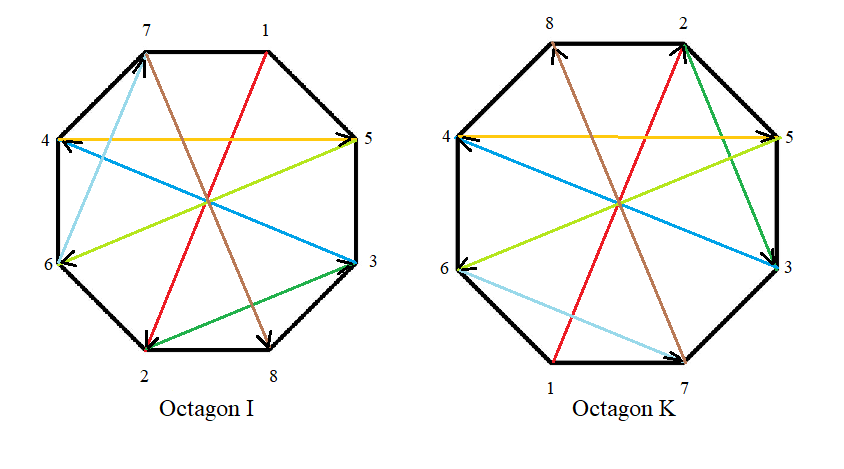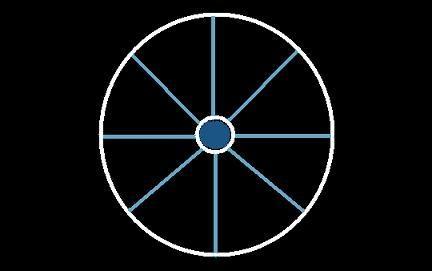Octagon Algorithm for Border Wheel Squares (Part X)
The Eight Node Way - (1,4,5) Squares
The previous sections Part IX introduced the Octagon I and J algorithm for the construction of 5×5 thru 11×11 Wheel Border Squares (WBS). The type of Wheel Border squares in Part IX was of the type (a,b,e). This section will look at WBS are of the type (a,d,e) where a and is 1, d is 4 and e is 5, i.e., the start of each wheel spoke is (1,4,5). The difference (Δ) between the terms in the central row spoke spoke will be modified so that one of the Δ terms is equal to 7 in one set of squares and 9 in the other. Otherwise the Δs are either 5 in the first set and 7 in the other. This is to ensure that the internal 3×3 square is magic, otherwise without this modification these (a,b,e) squares, unlike the (a,b,c), will be non magic.
To start, the wheel part of the square is first constructed using the (Δ) value of 5 followed by the non wheel portion (i.e, non spokes) which uses either the Octagon I (only the 5th order) and K algorithm to fill in the empty cells. The method can be summarized as follows where regular means with a degree of separation (Δ) between numbers:
a) the main diagonal is first filled in with the numbers from ½
(n2-n+2) to ½(n2+n)
b) the central row is the row to be modified with the last Δ value is 2 more than the current Δ value
filled in regular order starting at at the topmost cell and moving to the bottom cell
c) the left diagonal is filled in regular order starting at the right bottom cell and moving to the leftmost top cell
d) the central column is filled in regular order starting at the leftmost cell and moving to the rightmost cell

By first using the Wheel algorithm, square 5(05)k is filled using Δ=7 for the first central column spoke, while the left diagonal and central row are filled using a Δ= 5. The 7(05)ik and the 9(05)ik are both filled as usual except that the center column is first filled using Δ=5; followed by a final Δ=7;. The latter Δ=3 is always added last to ensure that the inner 3×3 square is magic. Once the wheel is complete the Octagon K algorithm is only used to complete the 5th order square. To complete the larger squares, Octagon I is used with the number 2 and Octagon K with numbers 12 and 19 for the 7th order square while Octagon I is used with the numbers 2, 12 and 25 and Octagon K with the numbers 22, 30 and 34 for the 9th order square:
Border 5(05)k
| 22 | 24 |
1 | 3 |
15 |
| 7 | 17 |
8 | 14 |
19 |
| 5 | 10 |
13 | 16 |
21 |
| 20 | 12 |
18 | 9 |
6 |
| 11 | 2 |
25 | 23 |
4 |
|
|
Border 7(05)ik
| 46 | 47 |
39 | 1 |
12 | 2 |
28 |
| 8 | 41 |
32 | 6 |
19 | 27 | 42 |
| 17 | 21 |
36 | 13 |
26 | 29 | 33 |
| 5 | 10 |
15 | 25 |
35 | 40 |
45 |
| 34 | 30 |
24 | 37 |
14 | 20 | 16 |
| 43 | 23 |
18 | 44 |
31 | 9 | 7 |
| 22 | 3 |
11 | 49 |
38 | 48 | 4 |
|
|
Border 9(05)ik
| 78 | 79 | 69 |
61 | 1 |
22 | 12 |
2 | 45 |
| 8 | 73 | 56 |
53 | 6 | 30 |
25 |
44 | 74 |
| 17 | 28 | 68 |
49 | 11 |
34 | 43 | 54 |
65 |
| 24 | 32 | 36 |
63 | 18 |
42 | 46 | 50 | 58 |
| 5 | 10 |
15 | 20 |
41 | 62 |
67 | 72 |
77 |
| 59 | 51 | 47 |
40 | 64 |
19 | 35 | 31 | 23 |
| 66 | 55 | 39 |
33 | 71 |
48 | 14 | 27 | 16 |
| 75 | 38 | 26 |
29 | 76 | 52 |
57 | 9 | 7 |
| 37 | 3 | 13 |
21 | 81 |
60 | 70 | 80 | 4 |
|
The caption in the tables is used for numbering the squares. For example, 5(05)k corresponds to n=5, 0 is the wheel type, 5 is the Δ and k is the algorithm used, in this case Octagon K; while the caption for 7(05)ik corresponds to n=7, 0 is the wheel type, 5 is the Δ and ik means that both algorithms, Octagon I and K, are used to develop the squares.
The 5th order square for this series is inconstructible. The 7(07)ik and the 9(07)ik are both filled as usual while the center column is first filled using a Δ=7; followed by a Δ=9;. The latter Δ=9 is always added last to ensure that the inner 3×3 square is magic. To complete the larger squares, Octagon I is used with the number 2 and Octagon K with the numbers 10 and 16 for the 7th order square while Octagon I is used with the numbers 2, 9 and 22 and Octagon K with the numbers 17, 30 and 34 for the 9th order square:
Border 7(07)ik
| 46 | 47 |
41 | 1 |
10 | 2 |
28 |
| 7 | 39 |
35 | 8 |
16 | 27 | 43 |
| 14 | 21 |
32 | 17 |
26 | 29 | 36 |
| 5 | 12 |
19 | 25 |
31 | 38 |
45 |
| 37 | 30 |
24 | 33 |
18 | 20 | 13 |
| 44 | 23 |
15 | 42 |
34 | 11 | 6 |
| 22 | 3 |
9 | 49 |
40 | 48 | 4 |
|
|
Border 9(07)ik
| 78 | 79 | 72 |
66 | 1 |
17 | 9 |
2 | 45 |
| 7 | 71 | 59 |
53 | 8 | 30 |
22 |
44 | 75 |
| 14 | 28 | 64 |
49 | 15 |
34 | 43 | 54 |
68 |
| 21 | 32 | 36 |
57 | 24 |
42 | 46 | 50 | 61 |
| 5 | 12 |
19 | 26 |
41 | 56 |
63 | 70 |
77 |
| 62 | 51 | 47 |
40 | 58 |
25 | 35 | 31 | 20 |
| 69 | 55 | 39 |
33 | 67 |
48 | 18 | 27 | 13 |
| 76 | 38 | 23 |
29 | 74 | 52 |
60 | 11 | 6 |
| 37 | 3 | 10 |
16 | 81 |
65 | 73 | 80 | 4 |
|
By first using the Wheel algorithm, square 11(05)ik is filled using Δ=5 for the first central column followed by one Δ=7. The latter Δ=7 is always added last to ensure that the inner 3×3 square is magic. The left diagonal and the central row are both filled in using only a Δ= 5. Square 11(07)ik is filled in using Δ=7 for the first central column followed by one Δ=9, while the left diagonal and the central row are filled using only a Δ= 7. The squares are filled as usual with the latter Δs always added last to ensure that the inner 3×3 square is magic. Once the wheels are complete the Octagon I and K algorithms are used to complete the 11th order squares:
Border 11(05)ik
| 118 | 119 | 109 |
100 | 94 | 1 | 29 |
21 | 12 |
2 | 66 |
| 8 | 113 | 89 |
85 | 82 | 6 | 41 | 36 |
32 |
65 | 114 |
| 18 | 35 | 108 |
77 | 73 | 11 | 49 |
44 | 64 | 87 |
104 |
| 27 | 39 | 47 |
103 | 70 | 16 |
53 | 63 | 75 | 83 | 95 |
| 31 | 43 | 51 | 55 |
98 | 23 |
62 |
67 | 71 | 79 | 91 |
| 5 | 10 |
15 | 20 |
25 | 61 |
97 | 102 |
107 | 112 |
117 |
| 92 | 80 | 72 | 68 |
60 | 99 |
24 | 54 | 50 | 42 | 30 |
| 96 | 84 | 76 | 59 |
52 | 106 |
69 | 19 | 46 | 38 | 26 |
| 105 | 88 | 58 | 45 |
48 | 111 | 73 |
78 | 14 | 34 | 17 |
| 115 | 57 | 33 | 37 |
40 | 116 |
81 | 86 | 90 | 9 | 7 |
| 56 | 3 | 13 | 22 |
28 | 121 |
93 | 101 | 110 | 120 | 4 |
|
| |
Border 11(07)ik
| 118 | 119 | 112 |
105 | 99 | 1 | 24 |
16 | 9 |
3 | 66 |
| 7 | 111 | 92 |
85 | 82 | 8 | 41 | 36 |
29 |
65 | 115 |
| 14 | 35 | 104 |
77 | 74 | 15 | 49 |
44 | 64 | 87 |
108 |
| 21 | 39 | 51 |
97 | 70 | 22 |
53 | 63 | 71 | 83 | 101 |
| 28 | 43 | 47 | 55 |
90 | 31 |
62 |
67 | 75 | 79 | 94 |
| 5 | 12 |
19 | 26 |
33 | 61 |
89 | 96 |
103 | 110 |
117 |
| 95 | 80 | 72 | 68 |
60 | 91 |
32 | 54 | 50 | 42 | 27 |
| 102 | 84 | 76 | 59 |
52 | 100 |
69 | 25 | 46 | 38 | 20 |
| 109 | 88 | 58 | 45 |
48 | 107 | 73 |
78 | 18 | 34 | 13 |
| 116 | 57 | 30 | 37 |
40 | 114 |
81 | 86 | 93 | 11 | 6 |
| 56 | 3 | 10 | 17 |
23 | 121 |
98 | 106 | 113 | 120 | 4 |
|
|
It's interesting that the Octagon I algorithm employs the set of triangular numbers (0,1,3,6,10,15...) with n(n+1)/2, while the Octagon I algorithm employs the set of natural numbers (1,2,3,4,...) in producing the squares. It's a reversal of Part IX where the Octagon I uses the natural numbers.
This completes the Octagon I and K method.
Go back to Part IX. Go back to homepage.
Copyright © 2022 by Eddie N Gutierrez. E-Mail: enaguti1949@gmail.com


